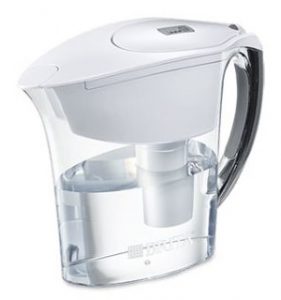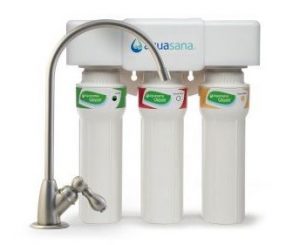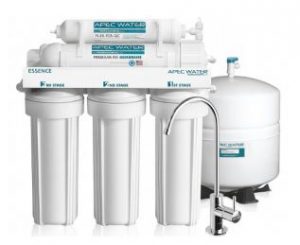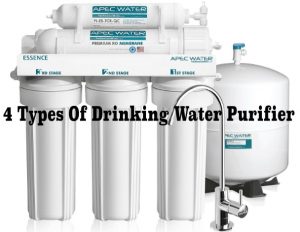Water Pitcher System
Water pitcher is the simplest form of drinking water purifiers system. It is lightweight, portable, and easy to use. It comes with a simple filtration system fitted inside the pitcher. A normal pitcher can purify up to 8 cups of water at a time.

The Pros
The basic water pitcher system can reduce the chlorine odor and taste of the water, heavy material such as zinc and mercury. Some of the pitchers can reduce lead as well.
It is handy and easy to bring around the house or outside while camping. The price is significantly lower than other types of water purifiers.
The Cons
It does not perform as great as a fully functional water purification system. There aren’t any numbers published by the manufacturer on the percentage of heavy material and chlorine that was reduced.
Constant filter replacement is needed as the filtration system is small and compact.
Price: $
Maintenance: On average of 40 gallons once or once every 2 months. $30-$40 a year
Major Brands: Brita, PUR, ZeroWater.
Summary: With this given price, there is no way you could say water purifier is expensive now. It is normal for students or graduates who have limited funds but wish to seek for better quality water.
Check out our latest comparison of Brita versus PUR which are the leading brand of water pitcher in the market.
Faucet Water Filter System

As explained from the name, it is mounted on to the faucet. This type of water filter doesn’t required additional pipe or electricity. There will normally be a lever which can switch between tap water and purified water.
The Pros
The faucet-mounted water purifier is able to remove the chlorine taste and odor, heavy material such as mercury, zinc, and lead.
Installation is very simple and can be done in less than 5 minutes.
The Cons
Similar to a water pitcher, it doesn’t reduce a lot of the harmful minerals as compared to other types of water purifiers. There are no data from manufacturers regarding the reduced percentage of those minerals.
No flexibility as it need to operate on faucets. However, it is easily dismantle and install in a new location.
Price: $
Maintenance: On average of 100 gallons once or once every 3 months. $30-$40 a year
Major Brands: Pur, Brita.
Summary: Although it is less flexible as compared to the water pitcher, but it is more efficient in filtering the heavy materials. In addition, the filtration time is faster as compared to the water pitcher.
Multi Stage Water Purifier System

Generally, most people will install a multi-stage water purifier system if they have the budget. A multi-stage water purifier comprises of pre-filter and a couple of stages on carbon blocks to remove minerals. In addition, some purifiers will have additional features such as ultraviolet light and alkaline treatment.
It normally comes with either a countertop or an under-sink model. The under-sink model is much preferred as it hides away the bulky look of the purifier.
The Pros
Most of the water purifiers in this category are certified and tested in the Water Quality Association (WQA) that removes up to 99% of the harmful minerals and bacterias.
Replacement filter are normally change once every year or a year and half.
The Cons
Bulky, not portable and often looks ugly which doesn’t match with the newly renovated kitchen.
Installation might be time consuming for some models as it is not a straight forward.
Price: $$
Maintenance: On average of 600 gallons once or once a year. $50-$100 a year
Major Brands: Aquasana, APEC, iSpring, Culligan
Summary: This category is suitable for normal household usage. It is a starter model for newlyweds or adult professionals. It is a brilliant certified model that provides clean and soft water to your family.
Reverse Osmosis Purifier System

Reverse osmosis (RO) is an advanced purifying method that forced the water through a semipermeable membrane to remove molecules, minerals, and huge particles in the water. RO water can be referred to as pure water because they are free from minerals.
Normally it is similar to a multi-stage purifier with an additional membrane filter that performs reverse osmosis at a later stage. It comes with an under sink and countertop RO water filter.
Some might argue that RO will filter the beneficial minerals such as calcium and magnesium which is a need in the human body. According to studies in WQA, the minerals in water are negligible compare to minerals that are consumed from food. You shouldn’t be too concerned if you constantly have food that contains calcium (milk) and magnesium (nuts).
The Pros
Water is purified at the highest level. Most of the minerals are filtered at 99% guaranteed.
Replacement of the first few stages are once a year and membrane filter normally is about 3-5 years.
The Cons
Large water usage will be wasted when filtering RO water. Most of the water molecules are not able to pass through the membrane due to contaminations.
Not portable and having an additional pressure tank to perform RO.
Price: $$
Maintenance: On average of 600 gallons once or once a year on the multi-stage filter and 3-5 years on the membrane filter. At least $70 a year
Major Brands: APEC, iSpring, Aquasana
Summary: This is a high-end category for water purifier systems that is able to filter 99% of the minerals which provide pure water to consume. Minerals in the water often can be negligible as they are insignificant as compare to the food that is consumed.
Choosing Your First Water Purifier
I would always recommend choosing based on your available budget. If you are able to spend about $10-$15 a month on water purification, you can have a decent multi-stage purifier install in your house.
What are you waiting for? Get your first drinking water purifier right now!
